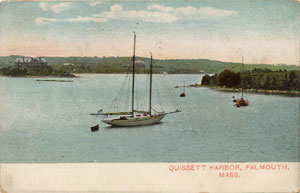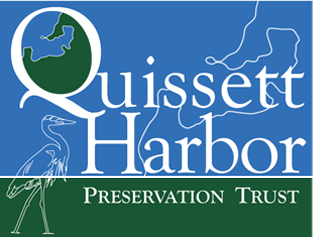
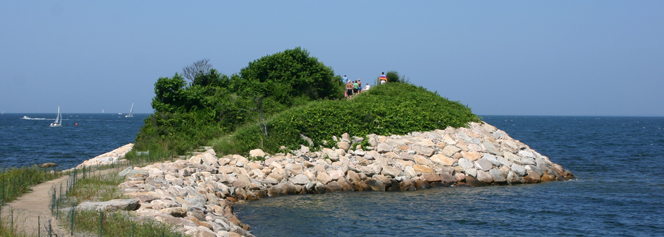
A Short History of Quissett
Quissett
Quamquissett
Wequamquissett
Wequomohquisett
Woquamquissett
Woquamquisit
Weiquomequesset
|
However the name is spelled, the Indian ties to Quissett pre-history are evident in the name. Molly Willet reports from an interview with Mrs. B. A. Tomkins that she had been told by an old Quissett resident that Quamquissett was the Indian equivalent for “Star of the Sea,” relating to five points of indentation on the shore: at the bay, Gansett, the outer harbor, Muddy Cove (below the present National Academy building) and the inner harbor.
In 1790, the first United States Census was taken. As far as can be determined, there appear to have been 10 heads of family at Quissett at this time. Lemuel Eldridge, Nathan Nye, Samuel Nye, Matthew Rowley, John Hammond, John Chadwick, Justus Rowley, Solomon Davis, Francis Davis and Silvanus Davis. In all, these households contained 68 individuals, averaging more than six people per household.
In the period of the first census and following first half of the 19th century, there is a record of Quissett developing as a real community with its own economy, institutions, and prominent citizens.
The 1845 U.S. Coast Survey Map, West Falmouth to Woods Hole, shows Quissett with two saltworks, one on the point of land leading to the Knob overlooking the inner harbor and the sand bar, and one above the present harbor road in the approximate location of Harbor Head cottage.
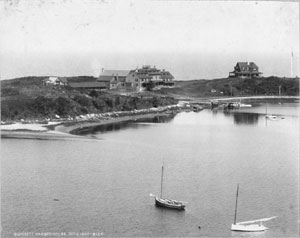 |
A view from the Quissett Avenue side looking at the Quissett Harbor House and “Petrel’s Rest”. Petrel’s Rest was built by Stephen W. Carey in 1890. Photo by Baldwin Coolidge, September 1897, Woods Hole Historical Collection. |
A shipbuilding company was formed at Quissett in 1802. Deacon Thomas Fish served as its first agent for a period of 10 years until the War of 1812. The vessels were launched just south of Hurricane Hall, Deacon Fish’s homestead, at the stone dock, of which only remains are visible now.
Other marine pursuits were also important in Quissett around this time. The “Ship Registers, District of Barnstable, 1814-1913” reveal that Quissett residents shared ownership in merchant and whaling vessels, some built in Falmouth and some elsewhere. Deacon Fish himself, who had a varied career as a Revolutionary soldier, schoolteacher, justice of the peace, selectman and member of the state legislature, also was in the West India trade and lumbering business, and commanded a vessel for several years.
The 1850 Federal Census lists 18 families in Quissett. Many of the households were large and contained in some instances several families within the unit, either related by marriage or, possibly, working on the household land. Occupations included carpenter, mariner, painter, farmer, salt manufacturer, mason, and cabinetmaker, with farmers and mariners dominating the list.
In this period, moving around the harbor to the north from Hurricane Hall and the marine activities of the stone dock, we come to the site of the Eldred homestead. The home on the site was probably built for Captain Lemuel Eldred (1751-1842) who owned vast amounts of land at Quissett which extended north into Racing Beach.
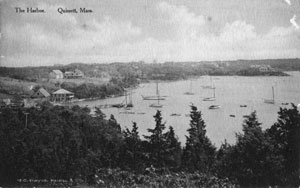 |
A view of Quissett Harbor from “Sunset Hill”. The Quissett Harbor boatyard is in the corner and beyond that is the “Homestead” belonging to the Fish family (later called “Hurricane Hall” by the Morse family). The Marshall house which became the present National Academy of Sciences is in the right background. From a postcard in the Fish/Morse Collection, Woods Hole Historical Collection. |
Completing a counter clockwise trip around the harbor in the last 25 years of the 18th century and the first half of the 19th, we come to what was, until recently, the Quissett Harbor House property and its environs. The dominant family on this site was the Hammond family. John Hammond seems to have come to Falmouth at the beginning of the 18th century from Rochester, Mass. At various times, up to three houses and two wharfs, together with outbuildings appear to have been built or moved onto the Harbor House site in the Hammond period.
With mid-century and the passing of the Hammonds, a change came to Quissett, the effects of which are still evident in the landscape and the community. During the 1860s and increasingly after the railroad came to Woods Hole in 1872, summer visitors came to stay as guests of the owners of the farm houses on the Neck at Quissett. In 1871, Susan Eldred Jenkins (Fish), then recently widowed, conveyed for $2,100 forty seven acres at Quissett, including her family homestead, to Jane W. Lewis of Little Rock, Arkansas (the wife of Colonel James M. Lewis).
At some point, probably as early as 1874, Colonel Lewis came to run or have run for him the Jenkins and Hammond houses as a hotel. These two houses were linked by a connector when the hotel came to be known as the Quissett Harbor House. From one of the early guest registers it is evident that many guests sailed over from New Bedford and environs for their visits.
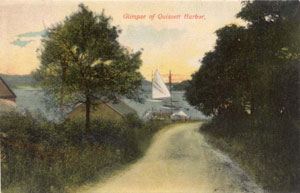 |
A view down the Quissett Harbor Road. From a postcard in the Fish/Morse Collection, Woods Hole Historical Collection. |
The details of exactly when and how the Careys first arrived at Quissett are not known, but Cornelia Carey (1891-1973) remembered that Stephen W. Carey (1831-1920) and his wife, Sarah Smith Boardman Yale (1846-1909) boarded at Hurricane Hall with their relations in the Fish household.
Stephen W. Carey at age 22 had founded his own freight brokerage firm in New York, later Carey, Yale & Lambert. In 1877, Stephen W. Carey began the first of many land acquisitions at Quissett, buying 16 acres for $2,000 from Harmonia Lewis, probably between the Woods Hole Road and the harbor. By far the most important transaction was his purchase of the Quissett Harbor House in 1881 from Jane W. Lewis for the sum of $9,675. The hotel developed a loyal following as a family resort, not just among visitors from New England but also and perhaps primarily among those from New Jersey and New York. Stephen Carey built the house known as Petrels Rest for himself and his family. His schooner, Petrel, lay at anchor in season in the harbor just below the house.
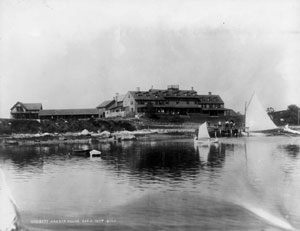 |
Quissett Harbor House, September 6, 1897. Photo by Baldwin Coolidge, Courtesy Historic New England. A popular summer hotel, the Harbor House opened in 1874 and closed in 1975. From left to right: the Cottage, the Alley (built from old saltworks), the Jenkins house (built ca. 1804) with dining room behind, the Connector, the Hammond house (built ca. 1790). The Jenkins house and the dining hall still remain; the Cottage and Alley have been reconstructed after a fire demolished them. |
In 1917, an announcement was made that the Quissett Harbor House would not open for the season. But by June of 1917, Lewis W. Francis of New York, resolved to open the hotel as a “family boarding house in a small way.” After a few seasons he persuaded Stephen W. Carey, Jr. to join him in supervising arrangements to open the hotel for the season and thereafter to take over the task himself. Later Cornelia Carey supervised the operation of the hotel.
Other parcels of land around the harbor were purchased for summer homes. Generations came and went and came again to the Quissett Harbor House while the community changed slowly around it. The Harbor House stood where it was, largely unchanged, “defying time, gathering traditions.” As time passed, some habitual guests rented Carey cottages or bought Carey land and built homes of their own.
In 1975, the Quissett Harbor House closed its doors for the last time, truly the end of an era. But, largely due to the generosity of Cornelia Carey, Helen Carey, other members of the Carey family and the work of individuals like Lewis W. Francis, Jr., Quissett did not go the way of developers, as did so many old summer resorts. Cornelia Carey left the outer part of the Knob property to Salt Pond Area Bird Sanctuaries, Inc. as a nature preserve, open for public access. The Carey family made possible the purchase of the central portion of the hotel property by the Quissett Harbor House Land Trust, Inc. under the leadership of Lewis W. Francis, Jr., thus preserving the social core of the old summer community and the historic buildings.
The Knob and the beach have become popular recreation areas for the Town and its visitors. At times, unfortunately, public access competes with the preservation of a natural habitat. Quissett has, however, passed on a rich tradition and environment which, with care and foresight, we will perhaps, preserve and not destroy.
Reprinted with permission from the Falmouth Historical Commission.
Historical Photographs reprinted with permission from the Woods Hole Historical Museum
